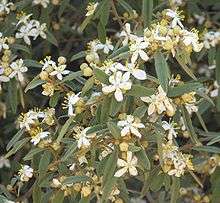Asterolasia hexapetala
| Asterolasia hexapetala | |
|---|---|
 | |
| Scientific classification | |
| Kingdom: | Plantae |
| (unranked): | Angiosperms |
| (unranked): | Eudicots |
| (unranked): | Rosids |
| Order: | Sapindales |
| Family: | Rutaceae |
| Genus: | Asterolasia |
| Species: | A. hexapetala |
| Binomial name | |
| Asterolasia hexapetala (Juss.) Druce | |
Asterolasia hexapetala is a shrub in the family Rutaceae. The species is endemic to the Warrumbungles in New South Wales in Australia. The Asterolasia grows to about 1.5 meters (4.5 feet) in height, mainly along water and Sclerophyll forest/woodlands in lower altitudes.
The name originates from the Ancient Greek words; aster, lasios, and hexapetala, meaning star, hairy (referring to hairs on the leaves), and six-petals.
Description
The leaves are greenish in colour covered in hair, 2–6 centimetres long, about 1-2 centimetres in width.
The flowers are 1-1.5 centimetres in diameter, usually white or white-yellow, with yellow stamens and rarely grow in clusters.
The aggregate fruit of Asterolasia hexapetala is a berry-like in structure, brownish in colour, and grows alongside the flower.
Taxonomy
The species was first formally described by French botanist Antoine Laurent de Jussieu in 1825, who gave it the name Phebalium hexapetalum. The species was transferred to the genus Asterolasia in 1917 by English botanist George Claridge Druce.[1]
Cultivation
The species prefers a moist, well drained and lightly shaded situation. Established plants are able to cope with dry periods. Plants may be propagated by cuttings or from seed, with some difficulty.[2]
References
- ↑ "Asterolasia hexapetala". Australian Plant Name Index (APNI), IBIS database. Centre for Plant Biodiversity Research, Australian Government, Canberra. Retrieved 30 July 2011.
- ↑ "Asterolasia hexapetala". Australian Native Plants Society (Australia). Retrieved 30 July 2011.
G.J Harden & B.J. Mole. "New South Wales Flora Online: Asterolasia hexapetala". Royal Botanic Gardens & Domain Trust, Sydney, Australia.